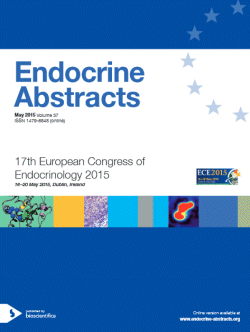Guided Posters
Pituitary–Therapy of Cushing's disease
ea0037gp.22.01 | Pituitary–Therapy of Cushing's disease | ECE2015
Phase III, multicentre, double-blind, randomised withdrawal study of osilodrostat (LCI699) in patients with Cushing's disease: a study design
Shimatsu Akira , Sauter Nicholas , Kelly Roxzana , Unge Peter , Zhi Xin , Fleseriu Maria
ea0037gp.22.02 | Pituitary–Therapy of Cushing's disease | ECE2015
Surgical outcome and factors associated with Cushing's disease recurrence in 101 consecutive patients operated on by a single pituitary neurosurgeon: the Cleveland Clinic experience
Johnston Philip C , Hamrahian Amir H , Bena Jim , Weil Bob , Kennedy Laurence
ea0037gp.22.03 | Pituitary–Therapy of Cushing's disease | ECE2015
Impact of preoperative magnetic resonance in surgical care of patients with Cushing's disease
Guelho Daniela , Martins Diana , Paiva Isabel , Cardoso Luis , Vicente Nuno , Oliveira Diana , Balsa Margarida , Carrilho Francisco
ea0037gp.22.04 | Pituitary–Therapy of Cushing's disease | ECE2015
Long-term (5 years) treatment of Cushing's disease with pasireotide
Petersenn Stephan , Salgado Luiz R , Schopohl Jochen , Portocarrero-Ortiz Lesly , Arnaldi Giorgio , Lacroix Andre , Ravichandran Shoba , Kandra Albert , Bagulho Teresa , Biller Beverly MK
ea0037gp.22.05 | Pituitary–Therapy of Cushing's disease | ECE2015
Effects of osilodrostat (LCI699) on cytochrome P450 enzymes in healthy volunteers indicates a low drug–drug interaction potential
Ting Lillian , Tripathi Anadya Prakash , Darstein Christelle , White Tracy , Sauter Nicholas
ea0037gp.22.06 | Pituitary–Therapy of Cushing's disease | ECE2015
A specific nursing educational programme in patients with Cushing's syndrome
Martinez-Momblan M Antonia , Porta Nuria , Gomez Carmen , Esteve Julia , Santos Alicia , Ubeda Inmaculada , Halperin Irene , Campillo Beatriz , Guillaumet Montserrat , Webb Susan M , Resmini Eugenia
ea0037gp.22.07 | Pituitary–Therapy of Cushing's disease | ECE2015
Neurosurgery outcome in patients with Cushing's disease with and without visualised pituitary adenoma on MRI, who underwent inferior petrosal sinus sampling
Belaya Zhanna , Khandaeva Patimat , Rozhinskaya Ludimila , Vorontsov Aleksandr , Sitkin Ivan , Grigoriev Andrey , Ivashenko Oksana , Dzeranova Larisa , Melnichenko Galina




